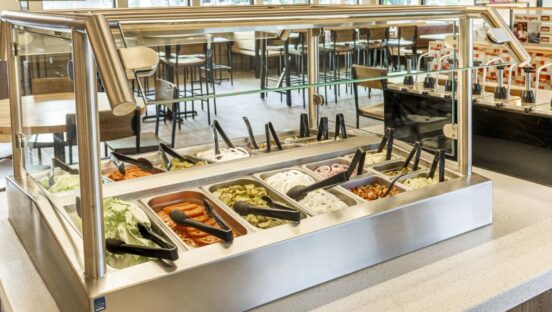Legacy brands, as well-established cornerstones in the quick-service restaurant industry, have maintained their appeal to generations of families across the country over many years, and this success is not a coincidence. These brands have earned the respect and loyalty of their patrons by rooting themselves in solid values with attractive menu offerings underpinned by a distinctive, heritage-driven identity. However, delivering transformative growth in today’s competitive marketplace presents many challenges.
As the industry evolves, one can count on new emerging chains to capture the spotlight while boasting cutting-edge technology and fresh menus and taking on creative marketing perspectives. These entrants are formidable, and many legacy brands with established names and ideals have struggled to keep up with their pace. But this trend doesn’t have to continue as longtime favorite establishments can maintain and expand their place in the crowded food landscape by executing a well-planned strategy of operating adaptability and innovation.
Adaptability—willingness to respond to industry trends
You can make innovative decisions for your restaurant without sacrificing tradition. For example, Roy Rogers invested in a substantive remodeling strategy following the COVID downturn, helping us improve brand relevancy as the economy recovered. With this strategy, Roy Rogers continued to pay homage to the West, while updating the look and ambiance of the restaurant to reflect the “modern cowboy.” With a good strategy in place, legacy brands can preserve the essence of their brand while pushing it forward toward modernization. “Refreshing” and redesigning can mean more than recreating. The dance between tradition and progress builds brand equity and positions iconic establishments to thrive in this new era.
When reflecting on the status of the quick-service industry over the past few years, stakeholders prioritized advanced technology, invigorated menus, and leveraged kitchen innovations as the best ways to enter markets, sell franchises, and scale quickly. Changing consumer behaviors and the quest for lower costs and more profitable operational efficiencies greatly influence this trend. However, other market forces, such as talent shortages, food supply, and the need for instant adoption and gratification among Gen Z patrons, also significantly affect how the industry operates. Therefore, to remain competitive and relevant, legacy brands must jump into this new era armed with a proactive attitude and the tools necessary to stay afloat.
At Roy Rogers, we are blessed with a unique “tool”—our iconic Fixin’s Bar—which allows guests to dress their sandwiches with fresh lettuce, freshly sliced tomatoes and onions, and pickles, along with an array of our signature sauces.
Every element of our brand’s storied traditions and hospitality-driven culture is ingrained in the use and popularity of this dining room centerpiece. We found that the Fixin’s Bar sets our brand apart, yet, as drive-thru and third-party delivery demand ramps up, we have had to adapt our known differentiator of offering fresh produce via a self-serve bar—to a prepared Fixin’s Cup.
This current evolution serves as a temporary adaptation while we regroup on what it means to innovate to provide for the next generation. How do we adapt and stay authentic while embracing change and pleasing a younger generation of consumers? We are working hard on this million-dollar question.
Authenticity—being true to yourself in a changing market
Authenticity takes on diverse meanings for different audiences, and it’s essential not to be pulled in conflicting directions. For example, legacy brands have the unbridled attention of faithful, original fans who have been with the brand since the beginning and value your allegiance and consistency. New brands don’t possess this influential customer segment; we see this dynamic every time a new store opens.
But the legacy’s growth challenge defaults to a middle customer group that respects the brand’s integrity and may have witnessed your peak of success but is more open to evolution as they don’t possess that heartfelt connection. And lastly, we have the newcomer generation of consumers, who were unfamiliar with the brand’s story as youths. It is marketing successfully to these two customer segments that hold the reins to a legacy’s future success. We believe that quality, variety, and choice will always appeal to these audiences.
While creating a transformation growth strategy, it’s crucial to align with these varied market perspectives and blend that traditional connection with the relevancy of modernization for a broader audience.
Brand equity is essential here, and brand leaders must look afresh to develop the best marketing and franchise sales strategy, customer loyalty programs, and potential synergies between the physical and digital sides of the business.
Further, brand transparency is equally important as building or maintaining equity. This dynamic is the art of refraining from assumptions and prioritizing intimate customer engagement. What are our customer’s accurate perceptions of the brand? Who is talking about us on social media? How can we interact with them to strike that chord of nostalgia?
Armed with this broader perspective, leaders can reset their focus to better drive operational and marketing effectiveness and test and scale menu and equipment innovation while intelligently and gently reminding customers that the brand is not old news; it’s just now getting started—and has the solutions to back that up.
It’s precisely at the intersection of adaptability and authenticity that legacy brands will thrive. With agility and awareness, brands can stay at the front of trends, embrace transformation, and deliver a constant flow of growth over time. Don’t be discouraged by the fast-growing brands that come and go around us. Confidence, values and brand equity will prevail, and you will have a roadmap for thriving in the new era of the quick-service restaurant industry.
Jim Plamondon is the co-president of Roy Rogers Restaurants.







